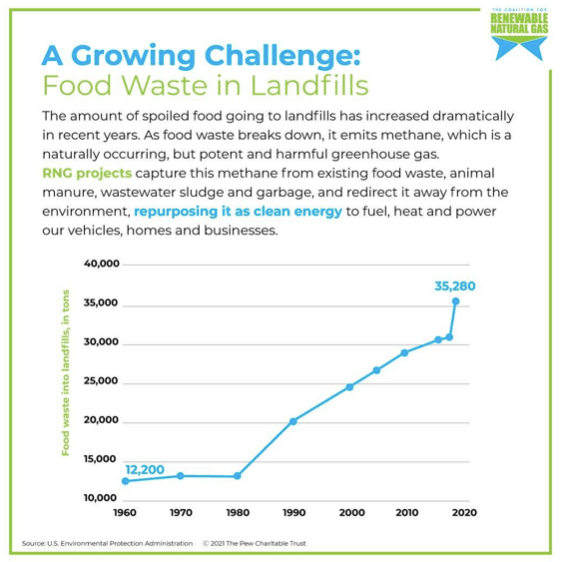As the world races to decarbonize, many industries and governments are turning to a hot, new technology for their energy needs: renewable natural gas (RNG). As RNG makes its way into business strategies and sustainability plans, it’s important to make sure we all have a clear understanding of what RNG is, the benefits it offers, and what it means for the clean energy transition.
What is renewable natural gas?
All living beings produce waste. As waste decomposes, it emits methane gas, which has more than 80 times the warming power of carbon dioxide after it reaches the atmosphere. Instead of letting that methane seep into the environment, RNG projects capture and use this methane as fuel.
RNG, also referred to as biomethane, describes biogas that has been upgraded for use in place of conventional natural gas. The biogas used to produce RNG can be sourced from livestock farms, solid waste landfills, wastewater treatment plants, waste products from food/beverage production, and organic waste management operations.
RNG takes a product that is negatively impacting the environment – waste – and creates clean and reliable fuel, creating a closed-loop for the carbon involved. On top of this, RNG is fully compatible with our current natural gas infrastructure and appliances – setting the stage for a smooth transition toward a productive role in the clean energy transition.
What are the benefits of renewable natural gas?

According to the U.S. Department of Energy, on a lifecycle basis, RNG can reduce GHG emissions by 95% as compared to diesel. The case for RNG’s impact on greenhouse gas reduction is most convincing within the context of landfills. The FDA estimates that more food reaches landfills than any other material found in our waste stream, making up 24% of municipal solid waste. RNG captures the gases released from decomposing waste that would otherwise decay and emit methane into the atmosphere. By capturing more greenhouse gas than it emits, RNG can be considered carbon negative. Additionally, the production of RNG (over time) will help to displace the need for drilling and fracking of fossil gas. Overall, RNG provides environmental benefits such as improved air quality, reduction of pollution, and provides a diverse fuel supply contributing to energy sovereignty.
In terms of reliability, RNG is available on demand through existing natural gas pipeline infrastructure and does not face intermittency issues that other renewable energy resources, such as solar and wind, may struggle with. Waste material can be converted into deliverable, renewable energy 24 hours a day, seven days a week, and can easily be deployed whenever and wherever needed.
How is RNG used?
RNG can be used for thermal applications, electricity generation, biobased plastics, or vehicle fuel. As it is injected and transported through the natural gas pipeline system, it can be used for any application that traditional natural gas would also serve. RNG molecules are indistinguishable from traditional natural gas molecules and displace conventional gas. The only difference is that RNG is derived from biological materials rather than from fossil fuel deposits.
For example, Microsoft will be using Enchanted Rock’s ultra-low emission generators in their new data center in San Jose, CA. The project will be the state’s largest renewable microgrid to date and will ensure that Microsoft’s data center operations run uninterrupted while also contributing to the company’s ambitious net-zero goals. When used as fuel for Enchanted Rock microgrids, RNG is a significantly more sustainable alternative to diesel backup generators (80-96% lower emissions than Tier 4 diesel standards).
What does the future of RNG look like?
The large-scale development of RNG faces some challenges, such as high production costs, feedstock availability, and other logistical constraints. Despite these current limitations, RNG has tremendous potential to address carbon emissions by converting waste gas into productive fuel, establishing a circular lifecycle for carbon in key industry sectors.
Current and future applications for RNG lie across multiple industries including agriculture, power generation, construction, and transportation– all known for their significant contributions to greenhouse gas emissions. As companies continue to realize the opportunities for RNG and demand increases, we’ll need to see cross-sector collaboration to unlock its full potential and take RNG mainstream.
We are excited to continue to be an innovator in the RNG space, bringing these innovative reduced emissions solutions to more customers. As RNG usage grows, the benefits will be widespread, including communities that experience cleaner air, customers who reduce their carbon footprint, farmers and other waste managers who can capitalize on their energy feedstock, and the environment as a whole. To learn more about RNG, read our full renewable natural gas overview.




















